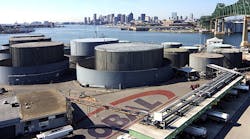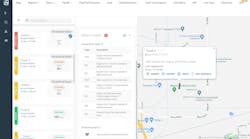THE reality of domestic meat production — be it beef, pork, or poultry — is that only 50% of the animal can be used in edible food applications. The rest of the inedible animal by-products are removed by rendering companies that take responsibility for their handling and transport by tanker truck and trailer. After these raw materials are brought into the rendering plant, they are turned into tallow, oils, grease, and meals that can be used by pet-care companies or animal-feed manufacturers. This operation requires a 100% commitment to the safety of its employees.
Recently, Carl Wintzer, vice-president of G A Wintzer & Son Company, an animal-rendering firm that has been a fixture in the small western Ohio town of Wapakoneta for more than 160 years, was assessing the safety of the plant's truck loading and unloading areas.
Employee safety is a crucial consideration because from the time the plant opens Monday morning until the work week ends Saturday at noon, it is a 24-hour beehive of activity, with trucks arriving and departing continuously from the company's two outdoor — where they're susceptible to the Midwestern elements — and three indoor fixed-position loading/unloading areas. With that in mind, Wintzer determined that an upgrade in the plant's fall-protection equipment was in order.
“We have a fleet of multi-purpose trailers that are loaded with the things that the meat companies don't use, things like blood, feathers, hair, hides, entrails, heads, and trim bones,” Wintzer said. “As we unload these things, particularly blood, I noticed that we didn't have a totally safe way to do that.”
While the G A Wintzer employees tasked with climbing to the tops of the trucks for loading and unloading were protected from slips and falls by a series of handrails and gangways, Wintzer was looking for a more standardized vehicle-access and fall-protection system. Turning to the Internet, he came across the name of SafeRack LLC.
“I saw that SafeRack had a standard piece of equipment that would fit or retrofit every loading and unloading situation we had, with a mind on increased safety,” said Wintzer, who is the fifth generation of Wintzers to lead the company, which began as a hide-tanning business in 1848. “A liquid load-out truck has a gangway that is about one-and-a-half feet wide with no handrails, so to go up there you have to have really good balance or there is potential for a fall. We wanted the guys to be more safe and sure-footed when they're up there.”
Working with SafeRack territory manager Travis McCraine, Wintzer chose SafeRack G4 Series Self-Adjusting Stair (SAS) Gangways to be installed at each of the five loading/unloading positions. These gangways are constructed using metal-stamping technology and a tool-and-die process to cut out pieces of aluminum, which are then bent into the required shape, eliminating the need for as many welds and creating a stronger, more durable gangway. Other features of the SAS equipment include spring-loaded gangway and platform operation, slip-resistant tread on the stairs, safety orange handrails and mid-rails, heavy-duty bumpers, and four-rail design for maximum fall protection.
Since the SafeRack fall-protection equipment was installed earlier this year, according to Wintzer the plant has realized a noticeable increase in worker safety, while the equipment fits hand-in-glove with the plant's varied loading and unloading operations.
“We use the SafeRack equipment multiple times a day for loading and unloading; we put the units in the busiest places that we have,” he said. “We have two in the finished-product locations where we handle animal fats and oils, and vegetable oils, and the other three are for raw materials. Animal blood was definitely one of our main concerns when we did this upgrade. In order to get the tank cleaned out as well as it needs to be, the truck has to be raised and hosed out. The guys used to have to go out above the tank to clean it out and it wasn't the safest for them. By using this equipment, the guys think about safety a little more. When they're on top of the truck, the SafeRack equipment has a guardrail that goes all the way around it, making it a much safer situation. I'm very satisfied at this point. The equipment is lightweight, robust and well-engineered. We're very happy with the way the equipment has performed.”








